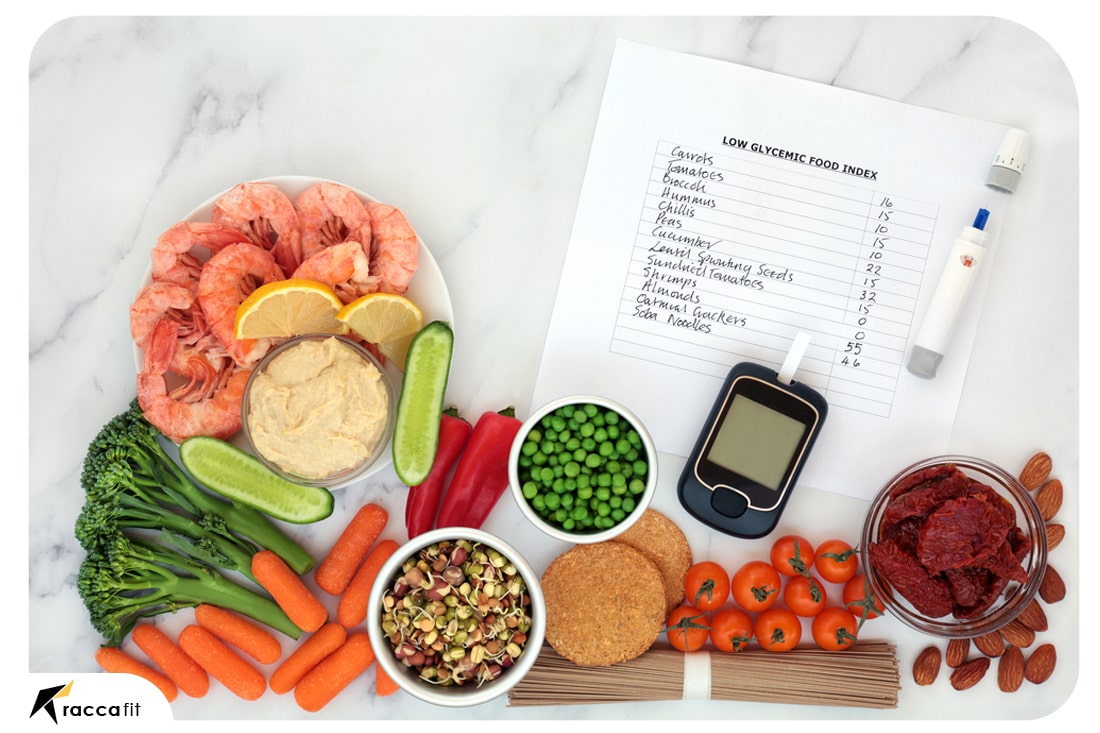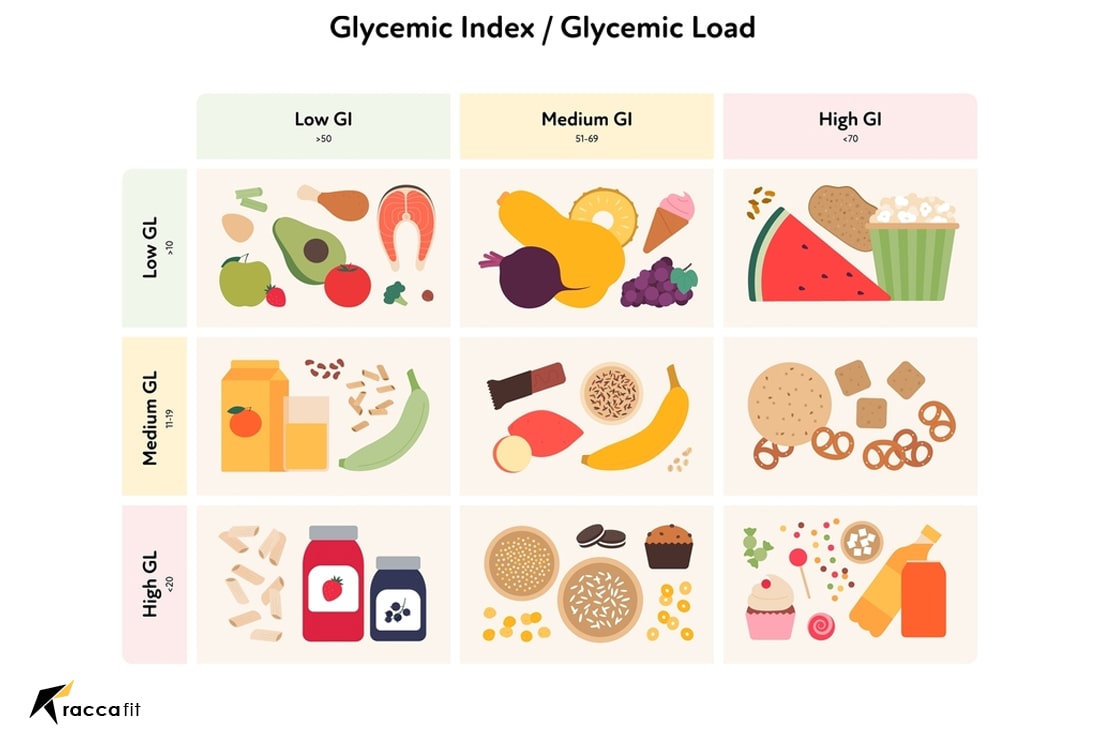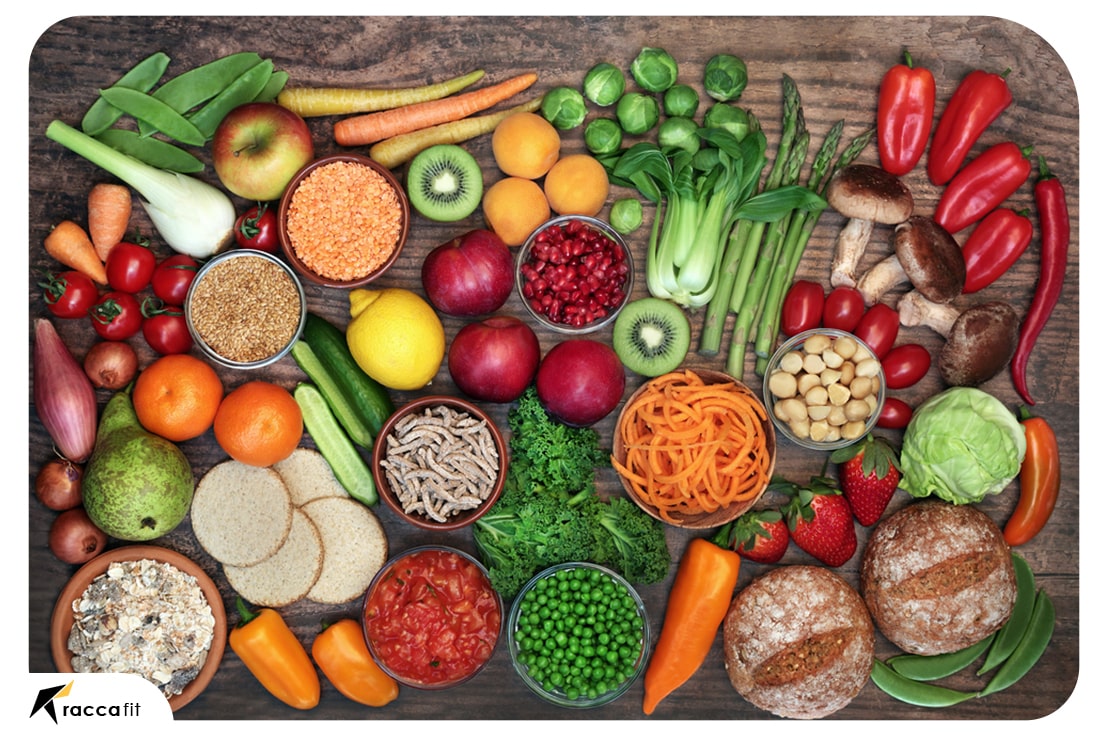At RaccaFit, we believe in the power of a well-balanced diet. Alongside regular exercise and a positive mindset, your dietary choices play a crucial role in determining your overall health and fitness outcomes. It’s a concept we explore in our article on the interplay between diet or exercise. However, with so many diets available, it can be challenging to decide which one suits your unique needs. That’s why we have developed this comprehensive guide to the 7-day low glycemic diet plan, a strategic dietary approach that focuses on maintaining steady blood sugar levels, supporting sustainable weight loss, and promoting overall wellbeing.
Understanding the Glycemic Index (GI)
Before diving into the specifics of the low glycemic diet, it is paramount to understand the Glycemic Index (GI), a fundamental concept underpinning this dietary approach. The Glycemic Index is a relative ranking of carbohydrate in foods according to how they affect blood glucose levels. Carbohydrates with a low GI value (55 or less) are more slowly digested, absorbed, and metabolized and cause a lower and slower rise in blood glucose and, therefore usually, insulin levels.
GI is categorized into three: low (55 or less), medium (56-69), and high (70 or more). High GI foods can spike your blood sugar levels rapidly, leading to a quick energy surge followed by a slump. On the other hand, low GI foods result in a slower, steadier increase in blood sugar and insulin levels. They provide sustained energy release, keeping you full and satisfied for longer. This is particularly important for those embarking on a fitness lifestyle, as stable energy levels mean better workout performance and enhanced weight management.

The Importance of Portion Control
In the world of nutrition, the phrase “everything in moderation” cannot be overstated. Even within a low glycemic diet, portion control is essential. Although low GI foods are healthier, overeating them can still lead to excessive calorie intake and consequently weight gain. Hence, the key lies in balancing the quality and quantity of food.
It’s also important to combine low GI foods with a balanced amount of proteins, healthy fats, and fibers to create a well-rounded meal. Remember, just because some foods have a low GI doesn’t mean they are universally healthy or can be eaten in large amounts. Always pay attention to the nutritional content of your meals.
7-Day Low Glycemic Diet Plan: A Daily Breakdown
Embarking on your 7-day low glycemic diet plan with RaccaFit is an adventure filled with discovery and satisfaction. Each day, we focus on meals that are not only nutritious but also delicious, combining varied ingredients in exciting ways to create dishes that are packed with flavor.
Day 1: Kick-start with Whole Foods
- Breakfast: Begin the day with a bowl of steel-cut oats topped with a mix of berries (blueberries, raspberries, strawberries) and a sprinkle of chia seeds. The fiber in oats and berries gives them a low GI score, keeping your blood sugar stable.
- Lunch: For lunch, opt for a grilled chicken salad filled with leafy greens, cucumber, bell peppers, cherry tomatoes, and a handful of kidney beans dressed with olive oil and lemon juice.
- Dinner: A hearty dinner could include grilled salmon, a serving of quinoa, and a side of steamed broccoli.
- Snacks: Almonds or Greek yogurt with a sprinkle of cinnamon.
Day 2: Experimenting with Legumes
- Breakfast: Scrambled eggs with spinach and a slice of whole-grain bread.
- Lunch: Lentil soup with a side salad made from mixed greens, cucumbers, and cherry tomatoes.
- Dinner: Grilled tofu stir-fry with a variety of colorful veggies like bell peppers, zucchini, and bok choy served over brown rice.
- Snacks: Hummus with carrot and celery sticks or a piece of fruit, like an apple or pear.
Day 3: Packed with Protein
- Breakfast: Greek yogurt with a handful of walnuts and fresh peaches.
- Lunch: Quinoa salad with grilled chicken, cherry tomatoes, cucumber, feta cheese, and a dressing of olive oil and balsamic vinegar.
- Dinner: Baked cod served with sweet potato and a side of sautéed green beans.
- Snacks: A small handful of unsalted mixed nuts or cherry tomatoes with mozzarella.
Day 4: A Taste of the Mediterranean
- Breakfast: Avocado and poached eggs on a slice of whole-grain bread.
- Lunch: Greek salad loaded with fresh vegetables, olives, feta cheese, and a drizzle of extra virgin olive oil.
- Dinner: Grilled lamb kebabs served with a tabbouleh salad.
- Snacks: Greek yogurt topped with a few berries or a handful of olives.
Day 5: Low Glycemic Comfort Foods
- Breakfast: Overnight chia seed pudding made with almond milk and topped with mixed berries.
- Lunch: Vegetable soup served with a slice of rye bread.
- Dinner: Oven-baked chicken with a side of roasted vegetables and barley.
- Snacks: A handful of pumpkin seeds or a pear.
Day 6: Plant-Based Power
- Breakfast: Smoothie made with spinach, Greek yogurt, a small banana, and a tablespoon of flax seeds.
- Lunch: Chickpea salad with cucumber, cherry tomatoes, red onion, and a drizzle of lemon vinaigrette.
- Dinner: Stuffed bell peppers with a mix of quinoa, black beans, corn, and topped with a sprinkle of cheese.
- Snacks: A small apple with a tablespoon of almond butter or a handful of roasted chickpeas.
Day 7: Balancing Act
- Breakfast: Whole-grain pancakes topped with a dollop of Greek yogurt and a handful of fresh berries.
- Lunch: Tuna salad made with canned tuna, mixed greens, cherry tomatoes, cucumber, and a hard-boiled egg with a dressing of olive oil and apple cider vinegar.
- Dinner: Grilled shrimp served over whole-grain pasta with a side of roasted asparagus.
- Snacks: A small orange or a handful of unsalted pistachios.
This plan provides a variety of nutrient-rich, low GI foods to help you maintain stable blood sugar levels, manage weight, and stay satisfied. Feel free to modify the plan according to your preferences and dietary needs. Remember, the aim is to make this low glycemic diet part of your lifestyle, so choose foods that you enjoy and can see yourself eating in the long term. Also check out our recipes for 10 low-calorie smoothies for a delightful, refreshing option that you can incorporate into your diet plan.
Recipes for Low Glycemic Dishes
Variety is the spice of life, and at RaccaFit, we firmly believe in diversifying your meals. With this in mind, we offer an array of low GI recipes ranging from breakfast options, light and filling lunches, hearty dinners, and healthy snacks to keep you satiated between meals.
For a healthy start to your day, consider a smoothie made from low GI fruits like cherries, plums, and grapefruits combined with a scoop of protein powder and a handful of spinach. For lunch, a salad filled with lots of green veggies, a portion of grilled chicken, and a drizzle of vinaigrette is a great option. Dinners can be a variety of protein sources like fish or lean beef with a side of steamed vegetables or quinoa. For those with a sweet tooth, Greek yogurt mixed with a sprinkle of nuts can make a satisfying dessert. Also, don’t forget to try our 14-day liquid diet weight loss plan which can be incorporated into the low GI diet for variety and additional health benefits.
Learn more: 10 Low Calorie Smoothies : Healthy and Delicious in a Glass
Tips for Sticking to a Low Glycemic Diet
Maintaining a low glycemic diet doesn’t have to be an uphill battle. Here at RaccaFit, we provide you with easy-to-follow strategies to help you stick to your diet plan and achieve your fitness goals.
- Planning ahead: Plan your meals ahead of time to avoid last-minute high GI choices. Keep a list of low GI foods at hand and make sure your pantry is stocked with these items.
- Food swap: Gradually swap high GI foods in your diet with low GI alternatives. For instance, switch from white rice to brown rice or quinoa.
- Stay hydrated: Often, we mistake thirst for hunger. Ensure you’re drinking enough water throughout the day.
- Eat regularly: Avoid skipping meals to prevent extreme hunger leading to overeating high GI foods. Aim to have 5-6 small meals throughout the day.
- Read food labels: Learn to read food labels to determine the GI and nutrient content of your food choices.
The Role of Exercise in a Low Glycemic Diet
A low GI diet plays a significant role in weight management, but it’s not a standalone solution. Regular physical activity is essential in achieving and maintaining a healthy weight. Exercise helps burn off extra calories that cannot be cut through diet alone.
At RaccaFit, we recommend a blend of cardiovascular exercises like running or cycling and strength training exercises such as weight lifting or resistance training. Our comprehensive guide to cardio exercises provides more details on various activities you can incorporate into your fitness regimen.
Strength training exercises like the glute kickbacks and bird dog exercise can be included in your workout plan for toning and strengthening various muscle groups. For those who prefer to exercise at home, we also offer an extensive workout at home guide, suitable for all fitness levels.

Understanding the Glycemic Load
When it comes to dietary choices, not all carbohydrates are created equal. While the Glycemic Index (GI) measures how quickly a food will raise your blood sugar levels, the Glycemic Load (GL) offers a fuller picture. The Glycemic Load combines both the quality and quantity of carbohydrate content in food, giving a more accurate estimate of how a particular food can affect blood sugar levels. It’s a more sophisticated tool than the GI alone and offers significant benefits to those managing certain health conditions or trying to lose weight.
How Is Glycemic Load Different from Glycemic Index?
The Glycemic Index and Glycemic Load might seem similar, but they differ in significant ways. The Glycemic Index only measures how rapidly a carbohydrate is digested and released as glucose into the bloodstream. However, it doesn’t take into account how much of that carbohydrate is in a serving of a particular food. This is where Glycemic Load comes in. It considers both the type of carbohydrate in a food (its GI) and the amount of carbohydrate in a serving. This combination gives us a more precise understanding of how food affects our blood sugar levels and insulin response, which is crucial for people managing diabetes, prediabetes, or those trying to maintain or lose weight.
The Importance of the 7-Day Low Glycemic Diet for Weight Management
The Glycemic Load is an essential tool in weight management. Foods with a lower GL often contain less processed carbohydrates and more fiber. These properties can help you feel fuller for longer, preventing overeating and aiding in weight loss. In essence, understanding and applying the concept of Glycemic Load to your diet can significantly enhance weight management, a point emphasized in our in-depth article on fat loss
Discover the Comprehensive Benefits of the 7-Day Low Glycemic Diet
A low glycemic diet isn’t just beneficial for weight loss—it offers a host of other health benefits as well.
How Does a Low Glycemic Diet Impact Heart Health?
A diet rich in low GI foods can be particularly beneficial for your heart health. These foods, such as whole grains, nuts, and legumes, are associated with lower levels of LDL (bad) cholesterol and higher levels of HDL (good) cholesterol. As high LDL cholesterol and low HDL cholesterol levels are risk factors for heart disease, following a low GI diet can contribute to a healthier heart. Additionally, low GI foods can help combat inflammation, a significant player in heart disease and other chronic health conditions.
Low Glycemic Diet and Diabetes Management
A low GI diet is a powerful tool in managing diabetes. Maintaining stable blood sugar levels is crucial for those with diabetes, and low GI foods can help achieve this by slowing the release of glucose into the bloodstream. However, following a low GI diet should be part of a comprehensive diabetes management plan, which should include regular medical supervision and, in some cases, medication.
Can a Low Glycemic Diet Improve Energy Levels?
One of the major advantages of a low GI diet is its ability to provide sustained energy. High GI foods can cause rapid spikes and subsequent drops in blood sugar levels, leading to energy slumps. Conversely, low GI foods release glucose into the bloodstream at a slower, more consistent rate, providing a steady energy supply throughout the day. This sustained energy can help improve productivity and reduce feelings of fatigue.
Potential Challenges and How to Overcome Them
Adopting a new diet always comes with potential hurdles, and a low GI diet is no exception. However, with a bit of planning and the right strategies, these can be overcome.
Debunking Common Misconceptions: 7-Day Low Glycemic Diet Plan Explained
One common misconception about low GI foods is that they are automatically healthy. But just because a food has a low GI doesn’t mean it’s necessarily nutritious. For example, a chocolate bar might have a lower GI than a bowl of watermelon. However, the chocolate bar also comes packed with unhealthy fats and added sugars. It’s therefore important to consider the overall nutritional profile of a food, not just its GI ranking.
Maintaining Variety in a Low Glycemic Diet
Keeping a diverse diet can be a challenge when focusing on low GI foods. However, a wide range of fruits, vegetables, legumes, and whole grains are all low GI foods. In addition, playing with different flavors, textures, and cooking techniques can help keep your meals varied and exciting. For instance, you could create a variety of delicious low GI smoothies using recipes from our 10 low-calorie smoothies guide.
Read-Life Transformation: The 7-Day Low Glycemic Diet Plan Explained
The benefits of a low glycemic diet aren’t just theoretical. Many of our RaccaFit community members have seen significant improvements in their health after adopting this eating approach. Whether it’s achieving weight loss goals, improving diabetes control, or boosting energy levels, the low GI diet has made a real difference in people’s lives.
How to Incorporate Exercise with the 7-Day Low Glycemic Diet Plan
Along with adopting a low GI diet, regular physical activity is an integral part of a healthy lifestyle. Both cardio and strength training exercises can complement a low GI diet, promoting weight loss, and improving overall health.
Complementary Workouts for Low Glycemic Diet
When following a low GI diet, it’s beneficial to engage in a blend of cardio and strength training exercises. Cardio exercises, such as running or cycling, help to burn calories and improve cardiovascular health. These are great ways to boost the benefits of your low GI diet, as we discuss in our cardio exercises guide. Meanwhile, strength training exercises help to build muscle, which can increase your metabolism and aid in weight loss.
The Role of Strength Training in a Low Glycemic Diet
Strength training is a vital component of a fitness regimen when following a low GI diet. As you build more muscle, your body burns more calories—even at rest. Exercises like the incline barbell bench press can help increase your muscle mass, boosting your resting metabolic rate and accelerating weight loss.
The Science behind the Low Glycemic Diet
There’s a wealth of research supporting the numerous benefits of a low glycemic diet. Studies have linked this eating approach to improved blood sugar control, weight loss, reduced heart disease risk, and increased feelings of fullness. We delve into these studies, giving you a comprehensive understanding of why the low glycemic diet works.

Meal Prep Tips for 7-Day Low Glycemic Diet Plan
Meal prep is a crucial part of successfully following a low glycemic diet. Here, we offer some useful tips.
Shopping for Low Glycemic Foods
When grocery shopping for a low GI diet, focus on fresh fruits and vegetables, lean proteins, and whole grains. These foods not only have low GI values but are also rich in essential nutrients. Try to avoid processed foods as much as possible—they often contain hidden sugars and unhealthy fats that can spike your blood sugar levels.
Cooking Techniques for Low Glycemic Meals
Preparing low GI meals doesn’t have to be complicated or time-consuming. With the right cooking techniques, you can create delicious and nutritious low GI meals with ease. Methods such as steaming, grilling, and baking are ideal for preserving the nutrients in your food. For more tips on preparing low GI meals, checkout our diet or exercise guide.
Conclusion
The 7-day low glycemic diet plan is more than just a diet—it’s a significant lifestyle change. Here at RaccaFit, we provide all the resources and support you need to make this journey easier and more enjoyable. With a host of benefits—from better weight management to improved heart health—the low glycemic diet could be the change you need to become a healthier, fitter you. We believe in the power of this diet, and we’re excited to see how it can transform your life too.
FAQS
- What are some examples of low GI foods? Some examples of low GI foods include whole grains, legumes, non-starchy vegetables, some fruits, and lean proteins.
- Can I only eat low GI foods on this diet? While the focus is on low GI foods, it doesn’t mean that medium or high GI foods are strictly off-limits. It’s about balance and moderation.
- Is the low GI diet suitable for everyone? While the low GI diet offers numerous health benefits, it’s always wise to consult with a healthcare professional or a dietitian before starting any new diet regimen.
- Can I lose weight with a low GI diet? A low GI diet can support weight loss by promoting satiety and controlling blood sugar levels. However, weight loss also depends on other factors like overall calorie intake, physical activity, and individual metabolic rate.
For further reading on related topics, feel free to delve into our other informative articles on RaccaFit. Join our community today and start your journey towards a healthier, fitter you!









1 thought on “7-Day Low Glycemic Diet Plan: Fuel Your Body Right”
Pingback: Diet Plan for Breastfeeding Mothers to Lose Weight